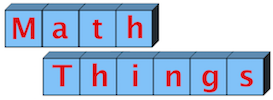Measurement with nonstandard units: hands and cubes
Here’s a beginning measurement idea (actually two ideas) for children in K-1 who are measuring with nonstandard units.
Don't kids just love to use their hands? Have them measure with them! They’re big and easy to use, and fun. “How many hands long is the table?…How many hands tall is your friend?…etc., etc.” Students do this individually. Show them how to place their hands down in sequence and you’re done. Then you can discuss why the table is 12 of Gina’s hands long, but only 10 of Jeremy’s. That’s idea #1.
Idea #2 is Unifix cubes. They’re big enough for small fingers to manipulate, put together, and take apart. And again, they’re fun to use. “How many cubes long is your desk?…your foot?…your pencil?…your cat? (!)"
Another thing I like about Unifix cubes is that their size is truly constant, just like standard units of length. It’s not like seeing how many paper clips long the paper is, for instance, where students can’t help but leave gaps and/or overlaps when they arrange the paper clips. Measurements made with Unifix cubes are as accurate as those made with a ruler. We always round to the nearest cube: “What’s it closer to, 8, or 9?”
The spoon is 8 cubes long, and the pencil is 9 cubes long.
How long is Colleen's cat?
Feature 2
The following is placeholder text known as “lorem ipsum,” which is scrambled Latin used by designers to mimic real copy. Mauris egestas at nibh nec finibus. Mauris egestas at nibh nec finibus. Nullam sit amet nisi condimentum erat iaculis auctor. Mauris egestas at nibh nec finibus. Mauris egestas at nibh nec finibus.
Feature 3
The following is placeholder text known as “lorem ipsum,” which is scrambled Latin used by designers to mimic real copy. Mauris id fermentum nulla. Quisque congue porttitor ullamcorper. Suspendisse nec congue purus. Donec ac fringilla turpis.


